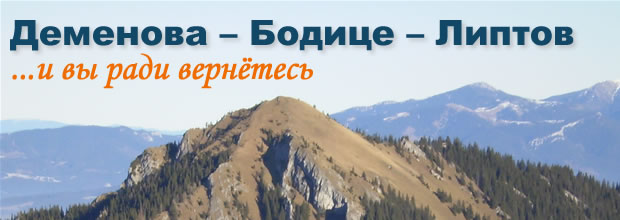History of Demänová and Bodice
Historically, Demänová is one of the
first Liptov's villages and was already mentioned in 1269 when King
Stephen V. presented the area to Poznan. In 1280 King Ladislaus IV.
confirmed the ownership of the area to Poznan and his son Damian, after
whom the village was named. A settlement of Lusatian culture from the
early Bronze Age was found in the area. Iron ores were mined in
Demänovská valley in 17th and 18th century and later lime was produced.
The inhabitants practised other crafts, too, tanning and production of
linen for example.A neighbouring village of Bodice was
mentioned in 1314 for the first time and the most famous of its owners
is the Bodicky family. The dominant part of the village is St
Ladislaus's Church which was built between years 1360-1380. In front of
the church there are protected lime-trees, which are the oldest in whole
Liptov region. In the surrounding area of the village there is Bodicky
pond. Nowadays, inhabitants of both villages are mainly engaged in
tourism because Demänovská valley became one of the
best known centers of tourism and winter sports in Slovakia.
Significant people:
Igor Rumanský (1946-2006) - painter,
Zoltán Palugyay (1898-1935) - painter,
Ján Gregorec (1914-1982) - university teacher, co-originator of History of Slovak literature.
Igor Rumanský (1946-2006) - painter,
Zoltán Palugyay (1898-1935) - painter,
Ján Gregorec (1914-1982) - university teacher, co-originator of History of Slovak literature.
Demänovská Ice Cave have
been known for a very long time. The openings to Demänovská Caves were
mentioned for the first time in a document of Ostrihom kapitula
published in 1299. The Demänovská Ice Cave was for the first time
mentioned in 1672 by J.P.Hain, who was interested in skeletons of cave
bears which he thought were skeletons of dragons. In 1719 G. Buchholtz
jr. had explored the cave and sent a description of it along with a
drawing of the cave to M. Bela who published these facts in 1723. In
1751 an emperor's commitee took a look on the cave. There are many
inscriptions on the walls of the cave and a great amount of books which
testify that scientists and also people of those times took interest in
the cave. There are signatures of many important persons of Slovak
history (M.M. Hodža, S. Chalupka, G. Fejérpataky-Belopotocký, etc.).
Demänovská Cave of Freedom
was discovered by A. Král with the help of A. Mišura in 1921. In 1923
temporary electric lighting was installed in the cave. In 1924 a part of
the cave, from Mramorové riečisko to Zlaté jazierko, was opened to
public. In 1925 'Družstvo Demänovských jaskýň' was created. It was an
organization, which had a job of taking care of both caves. An
expedition, led by A. Král, discovered four other parts of the cave -
Jánošíkov dóm, Panenská chodba, Chodba utrpenia and Červená galéria - in
1926. In 1928 a new opening to the cave was built and was used since
1930. In 1931 permanent electric lighting was installed and J. Zelinka
discovered Medvedia chodba. In 1933 he built a new opening from there
and hence changed the tour route. In 1986/1987 the connection with
Demänovská Cave Of Peace was achieved. Speleologists from SSS Demänovská
dolina achieved a connection of the cave with Cave under a Cliff and
Lower Cave in 1989, and a connection with Cave of Debris in 1992.
Speleologists from SSS local group
Demänovská valley had interconnected the Demänovská Cave of Freedom with
the Cave Under Cliff and Vale Cave in 1989 and with Cave of Slag in 1992
as well.
Copyright © 2007-2016
www.demanova.sk.
Кон такт: info@demanova.sk. Веб
Дизайн APweb.
Добавить в избранное | Сделать домашней страницей | Ссылки | Партнёры |

Добавить в избранное | Сделать домашней страницей | Ссылки | Партнёры |


























